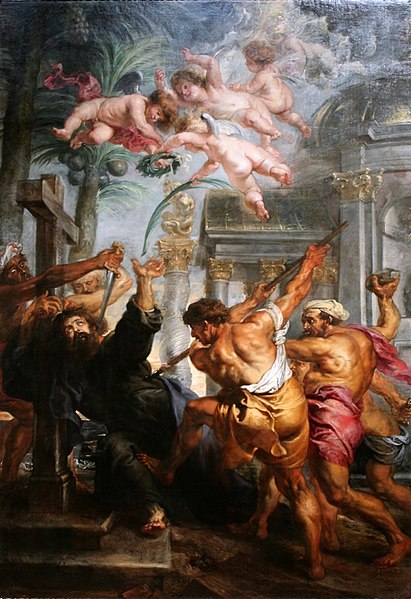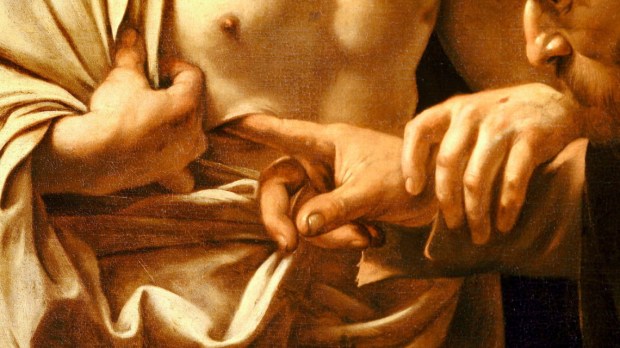Tradition has not been kind to St. Thomas, an intriguing apostle of Christ. Tarnished for his thick-headed insistence on a personal sensory verification of the Resurrection, Thomas has invariably inherited the role of a doubter. But through his frank skepticism emerged the undeniable confession of “My Lord and My God” and an inextinguishable spark of faith that set the world on fire.

But what happened to Thomas after his famous episode of incredulity? Was that the season finale? Well, the Acta Thomae, a document principally concerning the saint’s life, takes this story of faith forward. Legend states that in the act of mission territory distribution, India fell to the lot of St. Thomas. However, the apostle refused to venture into this foreign land. The “never giving-up” Christ then appeared in a supernatural way to Abban, an envoy of the Indian King Gundafor. Abban invited Thomas to serve his master as an architect. Thomas agreed and set sail to India.
This royally funded project involved building a palace for the King in the Roman style of art. But the gutsy Thomas distributed the entrusted treasury among the poor. King Gundafor was furious and had the saint imprisoned. Later he realised that the apostle’s intention was not to build a palace on earth where “moth and rust destroy and robbers break in and steal” (Matthew 6: 19-20). Instead Thomas desired to build an eternal palace in heaven through the noble acts of charity and love. The King had Thomas released and freed from trial. As the saint went about the country preaching the Good News, his faith was once again brought to task by King Misdai, who condemned him to death.
This absorbing multi-layered legend of the martyrdom of St. Thomas has been pulled together through the masterful brushstrokes of none other than the great artist Peter Paul Rubens. The painting in consideration invites us to the very depth of faith through the sensuous beauty of art and the spectacular warmth of color.
Rubens, a Flemish painter, strives to stimulate an Asian scene infused with symbols and stories. The drama unfurls in the foreground. Inspired by the classical sculptural model of the dying Laocoön, Ruben presents St. Thomas being persecuted by the powerful heathens.
Notice closely the appearance of the saint. Attuned to ancient tradition, St. Thomas is portrayed with incompta caesarie or “uncombed hair.” In addition, Thomas wears not an apostle’s garb but rather is presented in the cowl of a discalced Augustinian friar. His barefootedness is reminiscent of the Order’s observance of renouncing socks and footwear. The appearance of the saint connects us to the venue of the painting. It is displayed even today upon the high altar of the Church of St. Thomas in Prague, which belonged to the Barefoot Augustinian friars.
As the saint turns his gaze towards heaven, the persecutors, charged with anger, pounce upon him. One plunges a spear into his side, the other lunges a dagger at his neck. Still others hurl stones and kick him. The fury and pain of persecution embitters not the sufferer. In his right hand the dying apostle clutches the shaft of the stone cross which he himself had erected on foreign ground. His left hand reaches upwards as a descending choir of delightful cherubs bring him the wreath of glory. They present to him the palm of victory over death.
On either side of the stone cross spring two palms that serve as effective props. The nearest one has open seed heads and the one further bears coconuts. Symbolizing the fountain of life, they remind the dying apostle that it indeed is the Cross (read suffering) that wins everlasting life and freedom.
The background of the painting is as appealing as the narrative. Legend states that the missionary St. Thomas build a church at Kalamina in the South of India. It is here that his followers interred his body. Rubens depicts this church in the background to our right. He does so with an interesting and witty twist. Beyond the rows of Roman architectural elements such as the dome, porticoes, niches, pilasters and pillars, lies an exquisite Indian motif.
Notice the capitals of the gigantic columns. Each of them is embellished no longer with the European acanthus but rather with the oriental Indian elephant. Here, the elephant is imbued with more than just exotic value. Legend states that while constructing the church at Kalamina, St. Thomas moved a trunk of wood that several strong men and harnessed elephants could not budge a finger’s breadth.
Right before the sepulchre rises a spiral column alternately grooved and encircled with grapevines. It resembles the spiral columns that support Bernini’s baldachin in the Basilica of St. Peter at Rome. The difference of course is the crowning capitals ornamented with elephant heads. Upon the abacus of this capital is perched a curious bizzare figure. Characterized by its animal feet, horns and tail, it undoubtedly represents a demoniac idol. Legend states that this demoniac idol placed before the stone cross crumbled before the apostle’s death. Thus, once again it represents the triumph of the cross.
In the Gospels, St. Thomas is often referred to as Didymus, or “the twin.” Well, rightly so! For the life of St. Thomas is often a twin to our search and weaknesses in life. Yet, St. Thomas inspires us to continue to seek the light even in our moments of darkness and frailty. He encourages us to live our faith in action, to the very end. His professed faith was a victory over doubt and his suffering a victory over death.
This article is published courtesy of our partners in India, Catholic Indian Matters.

